ISU students and offenders work together to transform prison landscape. Video by Dave Olson.
AMES, Iowa -- There's no textbook for this. No recipe with precise measurements. No set of instructions for what they're doing. Because no one has done anything quite like this before: Improbable teams of college students and incarcerated women continue to transform acres of barren prison yard into a beautiful, bountiful landscape full of life — and now food.
The ongoing partnership between Iowa State University's Department of Landscape Architecture and the Iowa Correctional Institution for Women (ICIW) in Mitchellville is in its third year of providing hands-on learning experiences to students and offenders alike.
The students discover the pitfalls and rewards of putting their designs into practice, while the offenders gain meaningful vocational and life skills.
During the first project in 2013, the team constructed three multipurpose outdoor classrooms. Last year, they designed and constructed a decompression area for staff, and planted 260 trees and about one acre of native prairie flowers and grasses.
This summer, they have planted a nearly one-acre production garden of vegetables and herbs that is already producing significant yields — dozens of pounds daily. They've also designed and are installing a healing garden for the prison's special needs population.
Research has shown that healthy outdoor environments are restorative and can generate healing and rehabilitative effects, says Assistant Professor Julie Stevens, who leads the collaboration with ICIW Warden Patti Wachtendorf. Iowa Department of Corrections administrators have said they expect the project to become a national model for creating humane and restorative landscapes in a restrictive prison environment.
"The environment we give the women makes a difference in their attitudes and mentality," Wachtendorf said. "We're making this prison a little bit softer so that the women can make the changes needed to get out and not come back."
Growing veggies in the yard
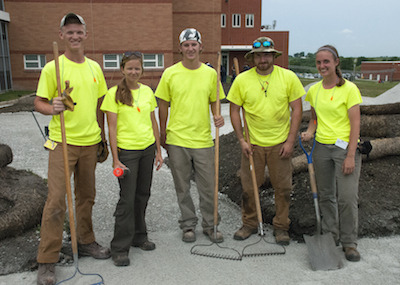
ISU team members from left: Jake Oswald, Assistant Professor Julie Stevens, Jake Stodola, Jacob Brouillette and Hannah Henderson. Photo by Alison Weidemann.
Stevens' five undergraduate landscape architecture students have been working on the prison project since February. The students, all seniors in landscape architecture, are: Jacob Brouillette, Des Moines; Jake Stodola, Shellsburg; Hannah Henderson, Fond du Lac, Wisconsin; Jake Oswald, Murray; and Kayla Volkmer, Des Moines. Graduate student Tara Bounds, Orion, Illinois, designed and supervised the prairie plantings last year and remains actively involved.
They worked with kitchen staff early on to determine how many of which vegetables to plant to help feed the more than 650 women at the prison. They settled on five vegetables — tomatoes, bush beans, sweet potatoes, potatoes and squash; and seven herbs — basil, lemon basil, lime basil, dill, thyme, cilantro and parsley.
Stevens estimates that the produce garden will provide as much as $60,000 worth of food to the ICIW kitchen this year and "we're just getting started."
Besides dealing with early summer rains and endless rabbits, they faced hurdles unheard of in backyard gardening: No stakes, nails, wires, strings or water hoses. Tools are only allowed when the ISU crew is on grounds. The use of tomato cages was debated and has led to some creative tomato cage designs that will keep the offenders busy creating them this winter.
Three days each week, a truck with a water tank parks next to the vegetable beds so offenders on the landscape crew can fill watering cans. It takes eight offenders more than an hour to water all of the beds.
"It took us awhile to figure out how to do it without hoses. It's not ideal, but the system is actually working better than I thought it might," Stevens said. “It seems daunting, but the women pay more attention to the plants when they water by hand, and then we have great conversations about their observations.”
One offender compared growing vegetables to raising a child: “First they started out as seeds and then came up above the ground, so they're born. Then they're just growing, but you have to care for and protect them."
The offenders spend the remainder of their eight-hour daily shifts, working side-by-side with the Iowa State students, setting stone block borders, building gravel paths and planting in the special needs garden.
"These women are on it. They're totally dedicated. They’ll even come out on weekends when we’re not here," Stevens said.
"We don't always know how we're going to solve all of our issues,” Stevens said. “But as long as we talk and work through them, we're going to do this."
A special garden place
Psychologists and counselors from the prison's special needs facility came to Stevens and her students, asking for a garden for those who have mental and physical health issues. They are mostly confined to the indoors and a secure patio unit overlooking a bleak landscape.
The students designed a therapeutic garden located on a gentle slope. It features seating areas and paths to a planter in the center courtyard. The planter bed will contain an interactive and varying display of seasonal plants, which the offenders with special needs could potentially manage. At the highest elevation of the garden, a limestone wall for sitting will fade into the hillside; at the lowest point, a rain garden will help handle storm water responsibly.
“They’ll have places to sit for privacy or for conversations,” said Oswald, the senior from Murray. “It's important that the women with special needs have a variety of options and feel safe and comfortable in this space.”
“We chose plants that have different colors and textures to be visually interesting and tactile,” said Henderson. “They can reach down to touch a soft leaf of the lamb’s ear plant. And we designed it so the plants will be like a mural when they’re looking from the upper stories of the healthcare building.”
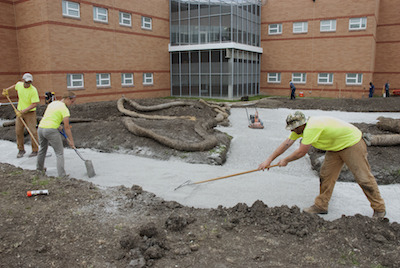
ISU students prepare paths in healing garden outside the ICIW special needs unit. Photo by Alison Weidemann.
On-site learning curve
The students have learned a great deal during the past six months, much of which could never be found in a textbook.
“We're learning a lot of communication skills,” Henderson. “For example, how to communicate with others who don’t know design jargon, or how to explain why something needs to be re-done.”
“After developing the plan, we had to figure out where to phase construction — that was challenging, especially given the security constraints,” Stodola said.
Oswald said that learning to think about the mechanics of the construction process — like whether or not a skid steer can fit through a space specified in your design — has been valuable. But the biggest lesson for him was being flexible.
“A lot changed once we got here. The more flexible you can be, the more successful you'll be on a site because it rarely goes as planned. We aim for the best-case scenario,” Oswald said.
Stevens laughed and agreed. "There are so many constraints that we can't function under any illusion of perfection out here. That's why 'best-case scenario' is one of my favorite phrases.”
The offenders are learning, too, Wachtendorf said. "The women here are really taking an interest in nature, which they never did before. They’re learning a lot and taking some ownership,” she said.
One offender has plans to pursue an associate degree in horticulture or landscape design when she gets out. Another offender said: “It’s a whole new world out here. This year, I’m learning more of the plant names like silky aster and black-eyed Susan. And I see that pulling weeds and raking rocks last year was worth all the sweat, tears and blisters. The flowers are really beautiful.”
Stevens, students and offenders are developing a curriculum on gardening to potentially create paths for offenders to seek education beyond prison.
“While we're teaching them about horticulture, landscape and design, they're also learning life skills, job skills, anger-management skills,” Stevens said.
Time to evaluate
“We're at the point where we need to see how we're impacting various populations. We'll survey the offenders to learn more about how they're using the outdoor classroom space,” Stevens said.
With help from the counseling staff, they'll also conduct a survey to identify offenders’ stress and depression levels before and after spending time in the new landscape. Stevens and Wachtendorf want to document impacts and share findings with other institutions to help them think differently about the prison environment.
“Hopefully, we’ll be able to show that the changes we're making are having positive impacts on offenders and staff and they feel calm and motivated by the work,” Stevens said. “We know we have women here who find this really restorative. They like giving back. They love the idea that they're growing food for their fellow inmates.”
ISU students prepare paths in healing garden outside the ICIW special needs unit. Photo by Alison Weidemann.
Contacts
Julie Stevens, Landscape Architecture, 515-294-6927, jstevens@iastate.edu (July 30-31 or after Aug. 17)
Patti Wachtendorf, Iowa Correctional Institution for Women, 515-725-5007, patti.wachtendorf@iowa.gov
Teddi Barron, News Service, 515-294-4778 or 515-509-3452, tbarron@iastate.edu
Quick look
Improbable teams of students and incarcerated women continue to transform acres of barren prison yard into a beautiful, bountiful landscape full of life — and now food. The ongoing partnership between Iowa State University's Department of Landscape Architecture and the Iowa Correctional Institution for Women (ICIW) in Mitchellville is in its third year of providing hands-on learning experiences to students and offenders alike.
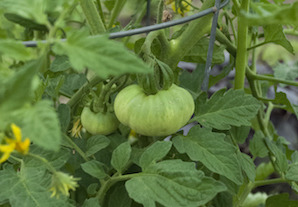
Tomato ripening. Photo by Alison Weidemann.
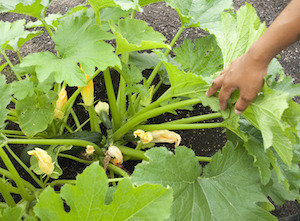
Squash ripening. Photo by Alison Weidemann.
Quotes
The environment we give the women makes a difference in their attitudes and mentality. We're making this prison a little bit softer so that the women can make the changes needed to get out and not come back."
Patti Wachtendorf, ICIW warden
"The more flexible you can be, the more successful you'll be on a site because it rarely goes as planned. We aim for the best-case scenario.”
Jake Oswald, ISU senior
"And I see that pulling weeds and raking rocks last year was worth all the sweat, tears and blisters. The flowers are really beautiful.”
ICIW offender
“We know we have women here who find this really restorative. They like giving back. They love the idea that they're growing food for their fellow inmates.”
Julie Stevens, assistant professor
Project donors
- Metro Waste — compost
- Hy-Vee — sweet potatoes
- Earl May Nursery and Garden Center — potatoes
- Seed Savers Exchange — seeds
- Midwest Ground Covers — perennial plants
- Iowa Department of Natural Resources — prairie plants
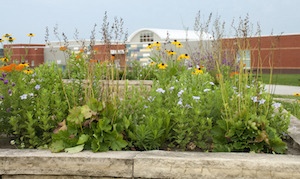
Prairie flowers planted last year. Photo by Alison Weidemann.
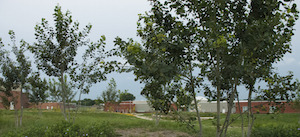
Aspen trees planted last year. Photo by Alison Weidemann.
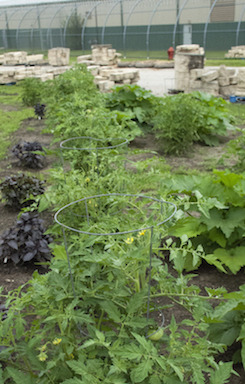
Vegetable garden. Photo by Alison Weidemann.
Previous News Service stories
Pounding the pavement will make these ISU students better landscape architects (Aug. 8, 2014)
Iowa State landscape architecture students create decompression area for employees of new prison for women (July 8, 2014)